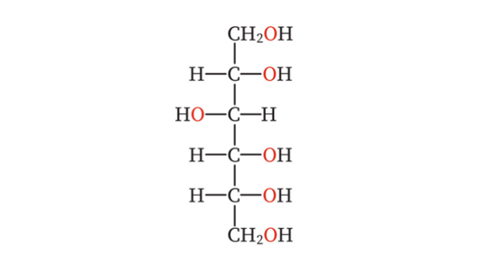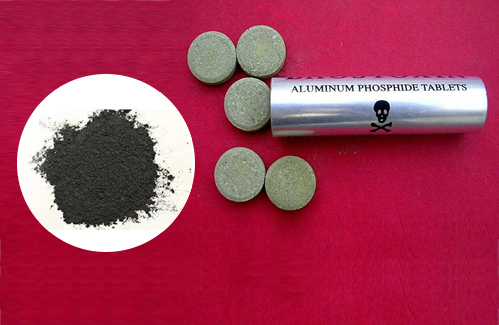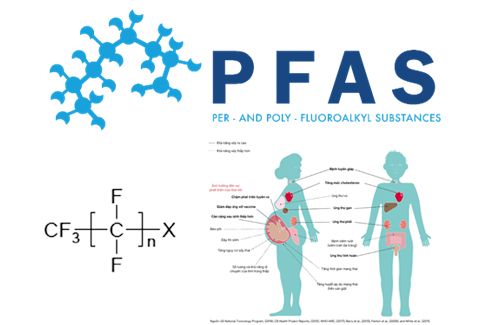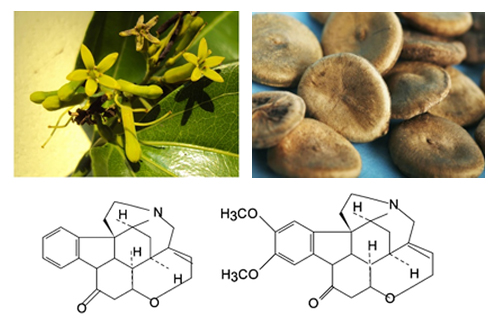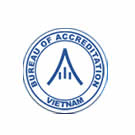- Folder Technical News
- Views 2939
- Last Updated 06/07/2024
Inositol, known as vitamin B8, is not really a vitamin but a sugar that plays an important role in the body as a key component of cell membranes. Inositol in milk has many different uses for the body, but it should be noted when using it to avoid unwanted effects.
1. Inositol
Inositol is a carbocyclic polyol compound that is essential for cell growth and survival. Inositol is commonly referred to as vitamin B8, but it does not meet the definition of a vitamin, so it is called a "fake" vitamin.2.
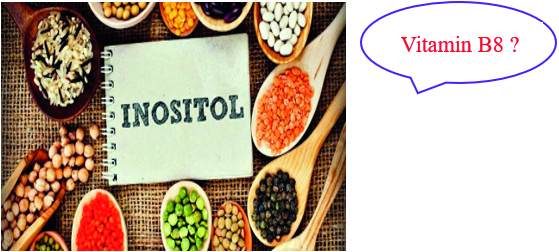
Inositol is found in many species of plants and animals. It is also synthesized from glucose in the human body and can be made in the laboratory. Inositol is most commonly found in fresh fruits, vegetables, and in foods containing nuts (beans, grains, and nuts).
Two common forms of inositol are free-inositol and phosphate inositol salt such as inositol hexaphosphate (IP6) – which is common in nature. There are nine stereoisomers of inositol in free-inositol.
- Structure
• The formula for the composition of nine isomers of free-form inositol is illustrated in Figure 1.

Figure 1: Structural formula of nine isomers of inositol
- Density: 1,752 g/cm3
- Melting Point: 224.5 oC
- Boiling Point: 291.33 oC
- Solubility: 0.17 mg/ml
Inositol hexaphosphate (IP6) is a dihydrophosphate ester of inositol, also known as phytic acid. In nature, inositol hexaphosphate (IP6) is found in many plants and mammalian cells, where it performs important messenger roles and affects many cellular processes. The construction formula is shown in Figure 2.
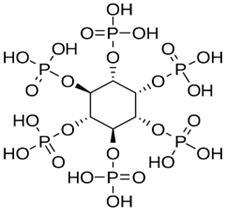
Figure 2: Formulation of inositol hexaphosphate
2. Uses of inositol
The types of inositol in Figure 1 all share the same uses of free inositol. Here are some of the uses of inositol:
- Inositol may help balance important metabolites in the brain including those that affect mood such as serotonin and dopamine [1].
- Researchers have found that some people with depression, anxiety, and obsessive-compulsive disorder have lower levels of inositol in the brain than the average person [2].
- Inositol may improve the symptoms of polycystic ovary syndrome (PCOS). Polycystic ovary syndrome is a condition that causes hormonal imbalances in women, which can lead to irregular periods and infertility. Weight gain, high blood sugar, and unwanted levels of cholesterol and triglycerides are also symptoms of PCOS. Clinical studies suggest that daily doses of inositol and folic acid may help reduce blood triglycerides and may improve diabetic function and blood pressure in people with PCOS [2]. In one study, 4 grams of inositol and 400 μg of folic acid taken daily for 3 months caused ovulation in 62% of the treated women.
3. Side effects
Studies have shown that inositol may provide a variety of health benefits, such as aiding in the treatment of panic disorder, improving symptoms of depression and anxiety, and may even help regulate problems related to the menstrual cycle and reproductive health in women. However, like every other supplement, inositol can also cause side effects, especially when used in high doses.
When inositol is used at a dose of 12 grams per day or higher, mild side effects such as nausea, bloating, difficulty sleeping, headache, dizziness, and fatigue will appear [6].

Figure 3: Images of some side effects of inositol at a dose of 12 grams per day or higher
For pregnant women, the use of inositol in high doses did not cause any significant side effects. In a study by Matarrelli, B et al., pregnant women were given a maximum dose of 4 grams of inositol per day [5], but caution should be exercised and followed by the advice of a doctor or medical professional.
In conclusion, inositol is a supplement that has the potential to provide many health benefits, but it also requires careful consideration and management to avoid unwanted side effects. Remember that safety and efficiency are always top priorities for those considering adding inositol to their diet. Do not hesitate to consult with medical professionals to get the most suitable and safest route to use inositol.
4. Testing inositol at the National Institute for Food Control
Currently, with many modern equipment and highly qualified staff, the National Institute for Food Control has developed an inositol analysis method by ion exchange chromatography combined with pulse amperage detector (HPAEC - PAD) and provides inositol testing services in food, food supplements, functional foods, health supplements, food additives, food ingredients, animal feed with high reliability, accuracy and speed.
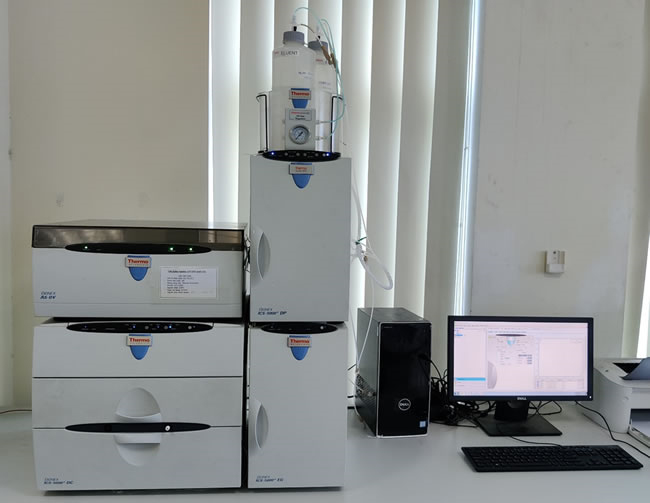
Figure 4: Image of HPAEC-PAD device using inositol analysis
Author Le Viet Ngan, et al at the National Institute for Food Safety and Hygiene Inspection published the article " Determination of myo-inositol content in milk by high performance anion exchange chromatography with pulsed amperometric detection (HPAEC-PAD)” - https://vjfc.nifc.gov.vn/vn/article?id=3819 on the Journal of Food Safety and Testing, using HPAEC-PAD with limits of detection (LOD) was 0.047 μg/g and the specificity, linearity, precision and accuracy parameters all met the AOAC requirements.
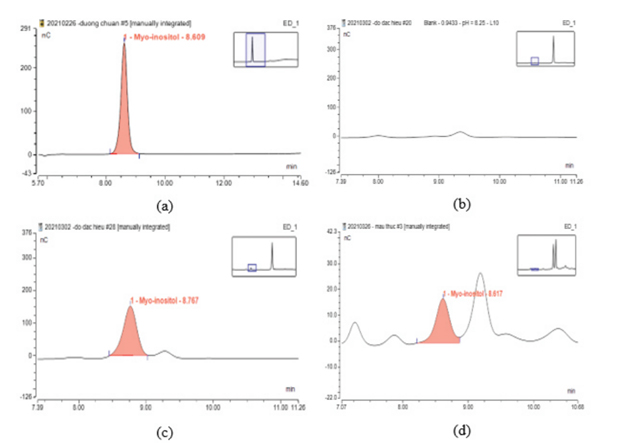
Figure 5. Chromatography illustration of 5 mg/L standard sample (a), blank sample (b), standard 5 mg/L additional blank sample (c), and real sample (d) analysis of myo-inositol in milk by HPAEC-PAD technique
The method has been applied to analyze free inositol and inositol phosphate salts to evaluate food quality. Also, it opens up the possibility of developing and applying high-performance ion exchange chromatography (HPAEC).
Author: Do Thi Hong Thuy
National Institute for Food Control
References
- Joseph Levine (1997). “Controlled trials of inositol in psychiatry”. European Neuropsychopharmacology, 7(2) pp. 147–155.
- Barkai AI, Dunner DL, Gross HA, Mayo P, Fieve RR. (1978). “Reduced myo-inositol levels in cerebrospinal fluid from patients with affective disorder”. Biol Psychiatry, 13(1) pp. 65-72.
- Kamenov, Z., Kolarov, G., Gateva, A., Carlomagno, G., & Genazzani, A. D. (2014). “Ovulation induction with myo-inositol alone and in combination with clomiphene citrate in polycystic ovarian syndrome patients with insulin resistance”. Gynecological Endocrinology, 31(2) pp. 131–135.
- Kalra, B., Kalra, S., & Sharma, J. B. (2016). “The inositols and polycystic ovary syndrome”. Indian journal of endocrinology and metabolism, 20(5) pp. 720–724.
- Matarrelli, B., Vitacolonna, E., D’angelo, M., Pavone, G., Mattei, P. A., Liberati, M., & Celentano, C. (2013). “Effect of dietary myo-inositol supplementation in pregnancy on the incidence of maternal gestational diabetes mellitus and fetal outcomes: a randomized controlled trial”. The Journal of Maternal-Fetal & Neonatal Medicine, 26(10) pp. 967–972.
- Carlomagno G, Unfer V (2011). “Inositol safety: clinical evidences”. European review for medical and pharmacological sciences, 15(8) pp. 931-936.





